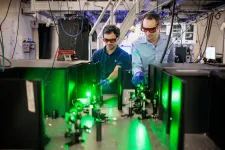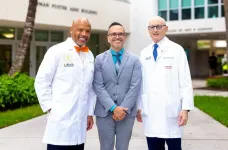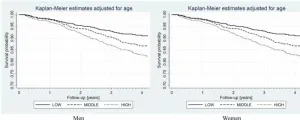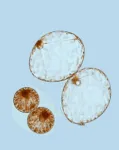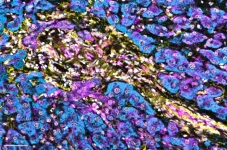(Press-News.org) Quantum defects have the potential to act as ultra-sensitive sensors that could offer new kinds of navigation or biological sensor technology.
One type of these defect systems, nitrogen vacancy (NV) centers in diamonds, can measure nanoscale magnetic fields. But while scientists can control the quantum spin of these centers — single defects in the diamond, where nitrogen has replaced the carbon — they still do not have a full understanding of how to best isolate that spin from the spins of other defects in the material, which can destroy its quantum state memory, or coherence.
Only by studying exactly how this material works at the atomic level can scientists and engineers realize these sensors’ potential. In new research at the University of Chicago Pritzker School of Molecular Engineering (PME), researchers in the lab of Prof. David Awschalom have devised a new way to harness the defect spin to measure the behavior of other single electron defects in the diamond.
This new understanding, published in Physical Review Letters, will be used to create even better quantum sensors that can maintain long coherence times.
“We have devised a way to see certain behavior of single quantum spin states that have otherwise proven elusive to standard measurements,” Awschalom said. “This will impact both how we engineer quantum systems and how we think about charge in many materials.”
Finding a way to measure background noise
Led by PME PhD graduate and current postdoctoral researcher Jonathan Marcks, the research team synthesizes these NV centers in facilities at Argonne National Laboratory. They grow diamond layer-by-layer through chemical vapor deposition, and can introduce only a few nanometers of nitrogen dopants to create single NV centers.
These single spin defects are highly coherent, but their spin is still sensitive to the behavior of other defect spins in the material. That’s because no matter how carefully the diamond is grown, it always ends up with unintended nitrogen defects that have their own spin. That causes decoherence in the system, affecting its usefulness as a sensor.
“Even if we have good control over where we put nitrogen, we always end up with this background noise,” Marcks said. “Because we want to grow highly coherent nitrogen vacancy centers, we wanted to better understand how these surrounding defects behave and couple with each other.”
Measuring a nearby electron charge
To better understand these single nitrogen electronic defects, the team used a laser and a home-built microscope system to measure the NV center. The number of photons that the NV center emits depends on the NV center’s spin state. Because these centers interact with other spins, the team realized they could use the NV center as a nanoscale sensor of the nearby nitrogen electron charge, which is otherwise invisible.
The process gave them the first-ever observation of coupled spin and charge dynamics within this material — right down to single defects.
“We expected the nitrogen defects would all just have a single charge state, but they actually flip back and forth, and they are not always in the same charge state,” Marcks said. “That’s different from what we assumed from solid-state physics.”
The team joined forces with Prof. Aashish Clerk and Prof. Giulia Galli, whose teams provided the theoretical and computational tools that allowed the researchers to better understand their observations.
Ultimately, the team will use this knowledge to not only better understand how these material systems behave but to also build better quantum sensors.
“By combining experiment, theory, and computation, we have ideas on how to create extremely clean materials for emerging quantum technologies and control some of these internal noise sources,” Galli said.
Other authors on the paper include Mykyta Onizhuk, Yu-Xin Wang, Yizhi Zhu, Yu Jin, Benjamin S. Soloway, Masaya Fukami, Nazar Delegan, and F. Joseph Heremans.
END
Measuring defects to better understand quantum systems
2024-10-17
ELSE PRESS RELEASES FROM THIS DATE:
Repurposing drug shows promise in fighting aggressive brain tumours: uOttawa study
2024-10-17
Glioblastoma is the most common – and the most malignant – primary brain tumour in adults. It’s aggressive and incurable. Even with treatment including surgical removal and chemotherapy, the median survival for patients is just 18 months.
Now, innovative new research led by Dr. Arezu Jahani-Asl, Canada Research Chair in Neurobiology of Disease at the University of Ottawa, provides highly compelling evidence that a drug used to slow the progression of the disease ALS shows promise ...
New initiative to fuel neuroscience and aging research
2024-10-17
Demonstrating its commitment to excellence as a member of the Association of American Universities and number one in the state for National Institutes of Health (NIH) funding, the University of Miami has pledged to invest more than $30 million to bolster basic science research that will target neuroscience and aging, some of the most complex conditions confronting the United States population, including in South Florida.
The investment over the next five years will create a new program in ...
WashU researchers use genetics to find psychopathology risks
2024-10-17
When trying to understand how genetic influences factor into youth behavior, researchers at Washington University in St. Louis have taken the “big trawl” approach, casting their net wide to pull in all the measured traits, behaviors and environments that make up who we are and examine associations with the genetic building blocks comprising risk for mental health problems.
This cutting-edge methodology has turned up valuable new insights into factors related to psychopathological genetic risk, ...
Fibroblast growth factor 21 and survival in the elderly: Polsenior2 study results
2024-10-17
“Of note, participants with high serum levels of FGF21 more frequently had metabolic complications, such as hypertension, obesity, diabetes, hypercholesterolemia, and hypertriglyceridemia.”
BUFFALO, NY- October 17, 2024 – A new research paper was published in Aging (listed by MEDLINE/PubMed as "Aging (Albany NY)" and "Aging-US" by Web of Science), Volume 16, Issue 19 on September 18, 2024, entitled, “Fibroblast growth factor 21 inversely correlates with survival in elderly population – the results of the Polsenior2 study.”
As ...
Plankton balloon to six times their size in newly discovered mode of oceanic travel
2024-10-17
Many plankton journey from the cold, dark depths of our oceans to the surface, only to eventually drift down again into the darkness in a perpetual rhythm. Yet, how single-celled phytoplankton, most of which have no appendages to help them swim, make this pilgrimage has remained a mystery. In a paper publishing October 17 in the Cell Press journal Current Biology, researchers describe a species of bioluminescent phytoplankton, called Pyrocystis noctiluca, that balloons to six times their original size of a few hundred microns. This massive inflation allows the plankton to journey up to 200 meters toward the ocean’s surface to capture sunlight, then ...
Repurposing drugs to eliminate cellular origins of brain tumors
2024-10-17
Glioblastomas are aggressive brain tumors with a median survival time of less than 22 months despite standard therapy including surgery, irradiation, and chemotherapy. It has become clear in recent years that not all cells within the brain tumor have an equal potential to divide and drive tumor growth. As such, a fraction of tumor cells called brain tumor stem cells (BTSCs) are thought to be the primary origin of tumor re-growth after surgery in addition to being resistant to standard treatments including chemotherapy and irradiation. Therefore, targeting BTSCs may be a way to effectively treat glioblastomas.
In an effort to rapidly identify ...
Biomarker may predict immunotherapy response in liver cancer
2024-10-17
It may soon be possible to determine which patients with a type of liver cancer called hepatocellular carcinoma would benefit from immunotherapy, according to a preclinical study by Weill Cornell Medicine investigators.
The study, published Oct. 17 in Molecular Cell, provides new insights into a pair of proteins, called p62 and NBR1, and their opposing functions in regulating the interferon response in hepatic stellate cells, a critical immune component in the liver’s fight against tumors. The study demonstrates that high levels of the immune-suppressing NBR1 in these specialized cells may identify patients who are unlikely to respond ...
Prevalence of glaucoma among US adults in 2022
2024-10-17
About The Study: This meta-analysis found that an estimated 2.56% of people 40 years or older have glaucoma, slightly more than estimated by previous studies. Black individuals are disproportionately affected. Prevalence estimates at the state and county level can help guide public health planning.
Corresponding Author: To contact the corresponding author, Joshua R. Ehrlich, MD, MPH, email joshre@umich.edu.
To access the embargoed study: Visit our For The Media website at this link https://media.jamanetwork.com/
(doi:10.1001/jamaophthalmol.2024.3884)
Editor’s ...
Effect of electric fans on body core temperature in older adults exposed to extreme indoor heat
2024-10-17
About The Study: Electric fan use did not lower peak core temperature in older adults exposed to extreme indoor heat. Reductions in end-exposure core temperature and heart rate were observed, but they were small and of questionable clinical importance. Neither exceeded previous suggestions for clinical significance. Consistent with recent modeling, these data do not support fans as an efficacious standalone cooling intervention for older adults in hot indoor environments (>33-35 °C).
Corresponding Author: To contact the corresponding author, Glen P. Kenny, PhD, email gkenny@uottawa.ca.
To ...
Buprenorphine/naloxone vs methadone for the treatment of opioid use disorder
2024-10-17
About The Study: Individuals receiving methadone had a lower risk of treatment discontinuation compared with those who received buprenorphine/naloxone. The risk of mortality while receiving treatment was similar between medications.
Corresponding Author: To contact the corresponding author, Bohdan Nosyk, PhD, email bnosyk@sfu.ca.
To access the embargoed study: Visit our For The Media website at this link https://media.jamanetwork.com/
(doi:10.1001/jama.2024.16954)
Editor’s Note: Please see the article for additional information, including ...
